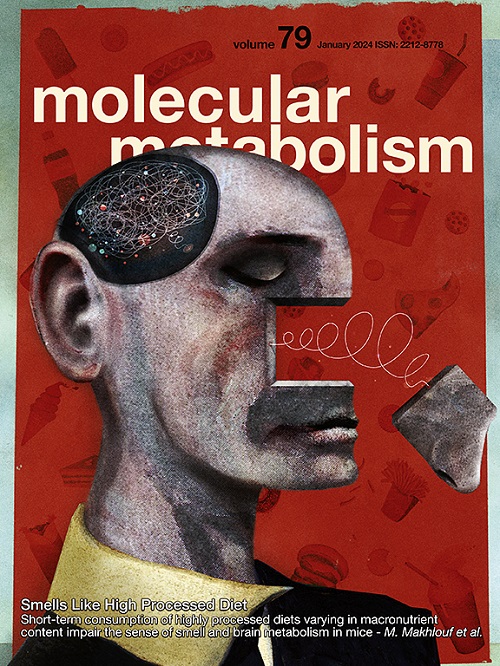Adipose tissue macrophage-derived miR-690 modulates adipocyte precursor cell maintenance and adipogenesis
IF 6.6
2区 医学
Q1 ENDOCRINOLOGY & METABOLISM
引用次数: 0
Abstract
Obesity is intricately linked to various metabolic diseases; however, some individuals maintain metabolic health despite being classified as obese. A critical factor underlying this paradox is the expansion of white adipose tissue (WAT), which can occur through two mechanisms: hypertrophy (the enlargement of existing fat cells) and hyperplasia (the formation of new fat cells from adipocyte precursor cells, or APCs). Hyperplasia is regarded as a healthier mode of WAT expansion, as it tends to reduce inflammation and protect against insulin resistance. Thus, interventions that promote hyperplasia over hypertrophy could improve metabolic health in obese individuals. In this study, we investigate the role of microRNA-690 (miR-690), an anti-inflammatory and insulin-sensitizing molecule, in maintaining the APC population and facilitating the healthy expansion of epididymal WAT (eWAT). Our findings indicate that in lean mice, macrophages support the APC population by transferring miR-690 to APCs. However, during obesity, the recruitment of pro-inflammatory lipid-associated macrophages (LAMs) to eWAT diminishes miR-690 delivery to APCs, impairing adipogenesis and leading to unhealthy WAT expansion. We demonstrate that strategies aimed at increasing the availability of miR-690 to APCs or mimicking its effects can restore APC functionality. Additionally, mutations in Nadk, the target of miR-690, were shown to mitigate the adverse effects of obesity on APC maintenance in eWAT. These findings suggest that targeting the miR-690-Nadk axis in APCs may provide novel therapeutic strategies to promote healthy adipose tissue expansion and protect against obesity-related metabolic diseases.
脂肪组织巨噬细胞来源的miR-690调节脂肪细胞前体细胞维持和脂肪形成。
肥胖与各种代谢疾病有着错综复杂的联系;然而,有些人尽管被归类为肥胖,但仍能保持代谢健康。这一悖论背后的一个关键因素是白色脂肪组织(WAT)的扩张,它可以通过两种机制发生:肥大(现有脂肪细胞的扩大)和增生(脂肪细胞前体细胞或apc形成新的脂肪细胞)。增生被认为是一种更健康的WAT扩张模式,因为它倾向于减少炎症并防止胰岛素抵抗。因此,促进增生而非肥大的干预措施可以改善肥胖个体的代谢健康。在这项研究中,我们研究了microRNA-690 (miR-690),一种抗炎和胰岛素增敏分子,在维持APC种群和促进附睾WAT (eWAT)健康扩张中的作用。我们的研究结果表明,在瘦小鼠中,巨噬细胞通过将miR-690转移到APC中来支持APC群体。然而,在肥胖期间,促炎脂质相关巨噬细胞(lam)向eWAT的募集会减少miR-690向apc的传递,从而损害脂肪形成并导致不健康的WAT扩张。我们证明,旨在提高miR-690对APC的可用性或模仿其作用的策略可以恢复APC的功能。此外,研究表明,miR-690的靶点Nadk的突变可以减轻肥胖对eWAT中APC维持的不利影响。这些发现表明,在apc中靶向miR-690-Nadk轴可能提供新的治疗策略,以促进健康的脂肪组织扩张并预防肥胖相关的代谢疾病。
本文章由计算机程序翻译,如有差异,请以英文原文为准。
求助全文
约1分钟内获得全文
求助全文
来源期刊

Molecular Metabolism
ENDOCRINOLOGY & METABOLISM-
CiteScore
14.50
自引率
2.50%
发文量
219
审稿时长
43 days
期刊介绍:
Molecular Metabolism is a leading journal dedicated to sharing groundbreaking discoveries in the field of energy homeostasis and the underlying factors of metabolic disorders. These disorders include obesity, diabetes, cardiovascular disease, and cancer. Our journal focuses on publishing research driven by hypotheses and conducted to the highest standards, aiming to provide a mechanistic understanding of energy homeostasis-related behavior, physiology, and dysfunction.
We promote interdisciplinary science, covering a broad range of approaches from molecules to humans throughout the lifespan. Our goal is to contribute to transformative research in metabolism, which has the potential to revolutionize the field. By enabling progress in the prognosis, prevention, and ultimately the cure of metabolic disorders and their long-term complications, our journal seeks to better the future of health and well-being.
 求助内容:
求助内容: 应助结果提醒方式:
应助结果提醒方式:


